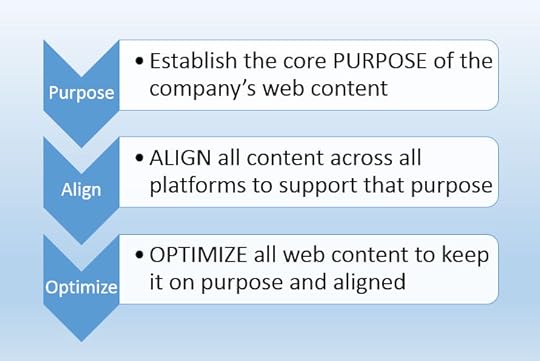Impress your clients – and earn more – with this simple Content Optimization Framework.
 There is a huge demand for quality web content.
There is a huge demand for quality web content.
The trouble is – for us writers – many, or maybe most companies have a nasty habit of low-balling us on price. They want great content, but don’t want to pay much for it.
When we tell them the content we write is worth more than they are offering, they may point us to sites like Freelancer.com, where they can find content writers for peanuts.
How can you break free from that kind of comparison?
First, you can build a reputation for yourself by insisting on writing only quality posts and pages. In other words, build a brand that demonstrates you are worth more.
That can work, but can also be tricky, simply because any measurement of “quality” can be subjective.
The other way to increase your perceived value in the eyes of your clients is simply to present yourself as more than a content writer.
Instead, introduce yourself as both a writer and a content marketing strategist. That may sound a little daunting or complicated, but it needn’t be.
A shortcut to becoming more than “just” a content writer is to present your clients and prospective clients with a framework.
What’s a framework? A framework is a fancy name for the description of a process.
Let’s create a framework you can use next time you pitch a client…
Any framework has steps, usually sequential steps.
Here is what ours is going to look like. (Feel free to borrow, steal or adapt it for your own use.)

This framework is made up of three sequential steps.
First, you need to sit down with your client and help them get clarity on the PURPOSE of their web content.
All too often companies publish reams of content simply because someone once told them to. They don’t have a plan, a strategy or any clear purpose behind what they do with their content.
So you need to ask them some questions and help them figure out what their content is intended to achieve.
For example, their core purpose may be to support online sales of their products or services.
Or it could be to generate leads. Or to attract inbound likes.
More often than not, a company will have more than one purpose in mind for its content. Your job is to help them clarify and prioritize how and when they deploy that content.
Second, you can help them make sure all their content is properly ALIGNED.
Creating web content isn’t just about blog posts.
Your client might also be publishing reviews to its site, creating videos, uploading images to Pinterest or Instagram, updating their Facebook page daily, and so on.
This second step in the framework is to help them align those different content channels so they are all pointing in the same direction at the same time.
All too often a company will have several individuals or teams working on different types of content, but without a shared plan or schedule.
Depending on the size of the company, getting everyone aligned almost always involves creating a shared calendar and making sure everyone’s content publishing efforts are aimed at the same target.
Third, ensure that all the content is OPTIMIZED to achieve its purpose.
Content should never be just “content”. It should always have a purpose. And content needs to be optimized to ensure that it is on-purpose.
Content intended to directly support a sales campaign needs to be optimized to pre-sell.
Content that is designed to build the authority of a company’s website needs to be optimized to attract inbound links.
And so on.
If the individual pieces of content published by a company, across all platforms, are not optimized, they’ll do a poor job of achieving their intended purpose – even if you have completed parts one and two of this framework.
To summarise…
You must achieve clarity of PURPOSE.
You must get all content publication platforms ALIGNED.
And you must ensure that every piece of content is properly OPTIMIZED.
Use this framework to increase your value and earn higher fees.
Like I said earlier, clients don’t like to pay much for content.
So don’t offer just content. Offer a Content Optimization Framework.
Companies love a good framework, and will pay handsomely to have it developed and executed. With a framework they can see what they are buying.
For yourself, you’ll be charging both for your time in helping them through all three stages of the process, and you’ll be charging them for writing the content as well.
It’s all about increasing a client’s perception of your value.
Content creation alone is perceived as low-value.
Application of a solid Content Optimization Framework will be perceived as high-value.
Give it a try and let me know the results.
NOTE: If you want to ramp up your expertise in the third step in this framework – content optimization – check out my course, Web Content Optimization.

If you found this post helpful, sign up for my e-newsletter and get a free copy of my 35-page guide…
Writing For The Web #1 — 7 Challenges every Writer and Copywriter faces when writing for the Web.
Sign up and I’ll send you the link for the download, and then you’ll receive my most recent post as part of my e-newsletter every Tuesday morning.
Sign Up for my Excess Voice Newsletter…
Name:
Email:
0 subscribers
We respect your privacy
Email Marketing by GetResponse
(Your email address will be used only for the purpose of sending you this newsletter, and you’ll be free to unsubscribe at any time.)
The post Impress your clients – and earn more – with this simple Content Optimization Framework. appeared first on Writing for the web - online copywriting and content writing..
Nick Usborne's Blog
- Nick Usborne's profile
- 6 followers




